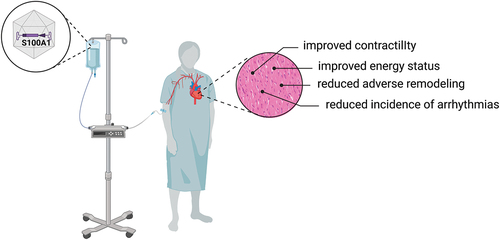Figures & data
Figure 1. S100A1 is a central regulator of the Ca2+-driven networks in cardiomyocytes. During cardiomyocyte’s excitation-contraction cycle, S100A1’s interaction with the RyR2 and Serca2a increases systolic Ca2+ cycling through the SR, and enhances diastolic RyR2 closure to prevent diastolic SR Ca2+ leakage. S100A1’s interaction with proteins at the myofilaments, such as titin, facilitates contraction as well as relaxation. In the mitochondria, S100A1 interacts with the ATP-synthase, which supports ATP synthesis.

Figure 2. Conceptual framework of S100A1’s therapeutic actions in the heart. S100A1 therapy could be administered via systemic AAV-gene transfer to heart failure patients. S100A1 has a broad therapeutic profile and results in improved contractility and an improved energy status, as well as reduced adverse remodeling and a reduced incidence of ventricular arrhythmias, making it a promising target for the treatment of heart failure. Created with BioRender.com.

